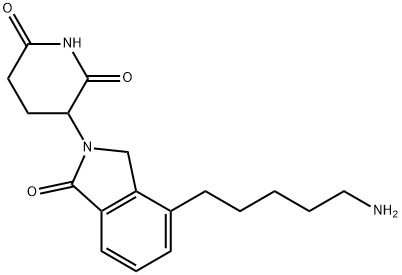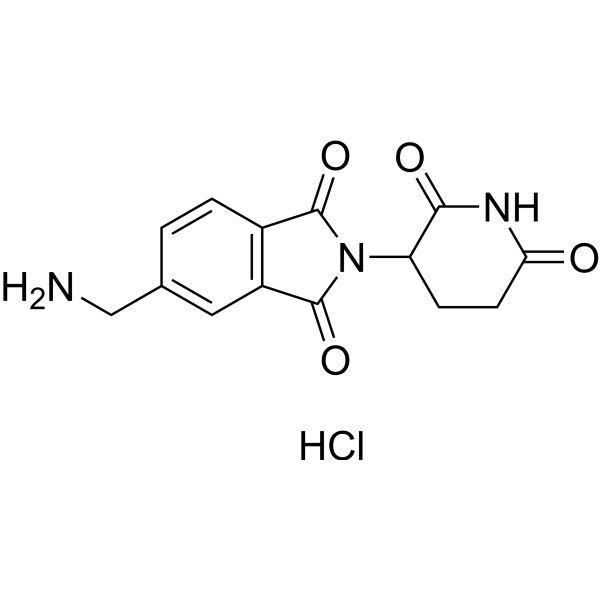 To enhance service speed and avoid tariff delays, we've opened a US warehouse. All US orders ship directly from our US facility.
To enhance service speed and avoid tariff delays, we've opened a US warehouse. All US orders ship directly from our US facility.
| Cat. No. | Product Name | Field of Application | Chemical Structure |
|---|---|---|---|
| DC11569 | E3 Ligand-Linker Conjugate 4 Featured |
An E3 ligase ligand-linker conjugate for PROTAC...
More description
|

|
| DC74503 | KH-103 Featured |
KH103 is a highly potent, catalytically-driven glucocorticoid receptor (GR) PROTAC degrader, demonstrate excellent performance in passively preventing ligand-induced gene expression activation in the absence of partial agonistic transcriptional triggering and crosstalk inhibition. KH 103 efficiently degrades glucocorticoid receptor (GR) in vitro and in vivo. In HEK293 cells, KH-103 (1 µM) induced rapid and nearly complete GR degradation within one hour. This degradation was highly potent, with significant depletion observed at 10 nM and near-complete depletion at 100 nM. KH-103 demonstrated effective and reversible GR degradation across diverse in vitro models from multiple tissues and species.Mechanistically, KH-103 promoted GR nuclear translocation but did not activate GR-mediated gene transcription and exhibited no nonspecific transcriptional effects alone. Furthermore, KH-103 effectively blocked dexamethasone (DEX)-induced GR signaling, demonstrating greater potency than comparator inhibitors.Critically, KH-103 also effectively depleted GR protein in the mouse pituitary gland in vivo and modulated corticosterone levels, confirming pharmacological activity beyond cell-based systems.
More description
|

|
| DC47206 | Thalidomide-5-CH2-NH2 hydrochloride Featured |
Thalidomide-5-CH2-NH2 (hydrochloride) is the Thalidomide-based cereblon ligand used in the recruitment of CRBN protein. Thalidomide-5-CH2-NH2 (hydrochloride) can be connected to the ligand for protein by a linker to form PROTACs.
More description
|

|
| DC60510 | Iso-A11B5C1 Featured |
Iso-A11B5C1 is an ionizable lipid. The iso-A11B5C1 LNP demonstrates a high level of muscle-specific mRNA delivery efficiency. exhibiting transfection efficiency comparable to the commercially available lipid SM-102, while considerably reducing inadvertent mRNA expression in main organs such as the liver and spleen.Additionally, study results show that intramuscular administration of mRNA formulated with iso-A11B5C1 LNP caused potent cellular immune responses, even with limited expression observed in lymph nodes.
More description
|

|
| DC77262 | YW-N-7 TFA |
YW-N-7 (TFA) is a PROTAC that targets both the inhibition and degradation of RET kinase, with a DC50 of 88 nM. YW-N-7 (TFA) exhibits antitumor activity in a KIF5B-RET-driven xenograft mouse tumor model and can be used in the area of cancer.
More description
|

|
| DC77261 | YN14-H |
YN14-H is a PROTAC degrader targeting KRASG12C. YN14-H inhibits cell growth in NCI-H358 and MIA PaCa-2 cells (IC50 values of 0.042, 0.021 μM, DC50 values of 28.9, 18.1 nM, respectively). YN14-H significantly induces apoptosis and inhibits migration. YN14-H demonstrates favorable pharmacokinetic properties and excellent antitumor activity in vivo.
More description
|

|
| DC77260 | TYD-68 |
TYD-68 is a highly efficient and selective CRBN-recruited TYK2 PROTAC degrader with a DC50 value of 0.42 nM. TYD-68 significantly inhibits IL-12 and IFN-α-induced STAT4 and STAT1 phosphorylation, thereby blocking TYK2-dependent signaling pathways.
TYD-68 can be used in the study of psoriasis.
More description
|

|
| DC77259 | TrimTAC1 |
TrimTAC1 is a PROTAC degrader that selectively targets the degradation of the multimeric protein Nucleoporin.
More description
|

|
| DC77258 | TO-1187 |
TO-1187 is a selective HDAC6 PROTAC degrader (DC50: 5.81 nM). TO-1187 promotes the ubiquitination and degradation of HDAC6 and can be used in the study of hematological malignancies and solid tumors.
More description
|

|
| DC77257 | Tamoxifen-PEG-Clozapine |
Tamoxifen-PEG-Clozapine is an estrogen receptor α (ERα) PROTAC degrader. Tamoxifen-PEG-Clozapine degrades ERα via a ubiquitin-proteasome system that uses the ubiquitin protein ligase E3 component N-recognin 5. Tamoxifen-PEG-Clozapine can be used for the research of cancer.
More description
|

|
| DC77256 | SMD-1087 |
SMD-1087 is a PROTAC that selectively targets SMARCA2 (DC50=8 nM, Dmax=89%) and SMARCA4 with a DC50 of 1 μM.
More description
|

|
| DC77255 | SJ44236 |
SJ44236 is the PROTAC degrader for BET that degrades BRD2 (DC50 = 0.127 nM), BRD3 and BRD4. SJ44236 exhibits cytotoxicity in cell MV4-11 and HD-MB03 with IC50s of 0.12 nM and 0.92 nM. SJ44236 downregulates the expression of c-Myc, upregulates the expression of p53. SJ44236 exhibits a good orally bioavailability of 45% in mice.
More description
|

|
| DC77254 | SD-2301 |
SD-2301 is a PROTAC based STAT3 degrader (Red: STAT3 inhibitor.
More description
|

|
| DC77253 | RP03707 |
RP03707 is a PROTAC based KRASG12D degrader (Red: KRASG12D inhibitor and may cause cross-immunoreactivity with anti-Forskolin antibodies.
More description
|

|
| DC77252 | RNAse L RIBOTAC |
RNAse L RIBOTAC (compound C64) is an RNA-degrading chimera which binds to a four-way RNA helix called SL5 in the 5’ UTR of the SARS-CoV-2 RNA genome and inhibits the virus replication in lung epithelial carcinoma cells.
More description
|

|
| DC77251 | RJS308 |
RJS308 is the PROTAC degrader for cyclosporin A (CypA) with a DC50 of 284 nM. RJS308 exhibits antiviral activcity through inhibition of HIV-1 and HCV replication.
More description
|

|
| DC77250 | RD-23 |
RD-23 is an orally active and selective RET PROTAC degrader. RD-23 promotes ubiquitination and degradation of RETG810C mutation, with a DC50 value of 11.7 nM. RD-23 inhibits the activation of downstream Shc signaling and induces Apoptosis. RD-23 can be used for the research of RET-related cancers.
More description
|

|
| DC77249 | PROTAC JNK1-targeted-1 |
PROTAC JNK1-targeted-1 (PA2) is a JNK1 PROTAC degrader, with a DC50 of 10 nM. PROTAC JNK1-targeted-1 (PA2) decreases the level of Fibronectin protein. PROTAC JNK1-targeted-1 can be used for the research of pulmonary fibrosis.
More description
|

|
| DC77248 | PROTAC CG167 |
PROTAC CG167 is a selective and potent CypA PROTAC degrader. PROTAC CG167 degrades CypA in a dose-dependent manner (Jurkat: DC50: 123 nM). PROTAC CG167 can inhibit HIV-1 and HCV and exhibits antiviral activity.
More description
|

|
| DC77247 | P1D-34 |
P1D-34 is a Pin1 PROTAC degrader with a DC50 value of 177 nM. P1D-34 also down-regulates Pin1 client proteins such as Cyclin D1, Rb, Mcl-1, Akt, and c-Myc. P1D-34 shows anti-proliferative activities in a panel of acute myeloid leukemia (AML) cell lines. P1D-34 induces cell DNA damage and apoptosis by releasing ROS generation.
More description
|

|
| DC77246 | OICR41114 |
OICR41114 (PROTAC 4) is a WDR5-targeting PROTAC degrader. OICR41114 degrades endogenous WDR5 with an EC50 and Dmax values of 40 nM and 49%, respectively. OICR41114 degrades HiBiT-tagged WDR5 in a proteasome-dependent manner. OICR41114 is composed of target protein ligand Dimethyl-F-OICR-9429-COOH, E3 ligase ligand OICR-8268-acrylic acid and PROTAC linker Amino-PEG9-amine. The conjugate of E3 ligase ligand and linker is OICR-8268-acrylic acid-amino-PEG9-amine).
More description
|

|
| DC77245 | NU227326 |
NU227326 is the PROTAC degrader for Indoleamine 2,3-dioxygenase 1 (IDO1) with DC50 of 4.5 nM. NU227326 degrades IDO1 in cell U87 and GBM43 with DC50 of 7.1 nM and 11.8 nM. NU227326 exhibits good pharmacokinetic properties with a plasma half-life of 5.7 hours and a brain tissue half-life of 11.8 hours.
More description
|

|
| DC77244 | MS479 |
MS479 is a BRD4 PROTAC degrader. MS479 binds BRD4-BD2 and GLP with high affinities (BRD4-BD2: Kd = 200 nM; GLP: Kd = 306 nM). MS479 can reduce the protein level of BRD4 short isoform. MS479 recruits the E3 ligase SPOP by directly binding its substrate GLP as a bridge protein. MS479 can be used to inhibit the proliferation of colorectal cancer cells.
More description
|

|
| DC77243 | MS2133 |
MS2133 is a DOT1L PROTAC degrader. MS2133 promotes ubiquitination and degradation of DOT1L in THP-1 and MV4-11 cells (DC50: 56 nM and 25 nM, respectively), and reduces H3K79 methylation. MS2133 inhibits the growth of MLL-r leukemia cells and has anticancer activity.
More description
|

|
| DC77242 | MD-265 |
MD-265 is a PROTAC degrader that can break down MDM2, leading to activation of p53 in cancer cells carrying wild-type p53. MD-265 achieves complete tumor regression and improves long-term survival of mice with leukemia.
More description
|

|
| DC77241 | LZ-07 |
LZ-07 is a IRAK4 PROTAC degrader (DC50 = 1.14 nM). LZ-07 leads to marked suppression of cytokines including IL-6, IL-1β, TNF-α, and IL-10 upon degradation of IRAK4. LZ-07 can be studied in research for autoimmune diseases.
More description
|

|
| DC77240 | KI-CDK9d-32 |
KI-CDK9d-32 is a CDK9 PROTAC degrader (DC50: 0.89 nM). KI-CDK9d-32 promotes the ubiquitination and degradation of CDK9. KI-CDK9d-32 inhibits the MYC pathway and disrupts nucleolar homeostasis. KI-CDK9d-32 has anticancer activity.
More description
|

|
| DC77239 | JB300 |
JB300 is a highly selective Aurora A degrader based on PROTAC technology (DC50=30 nM). JB300 can be used for tumor research.
More description
|

|
| DC77238 | HP211206 |
HP211206 is a SARS-CoV-2 main protease (Mpro) PROTAC degrader. HP211206 effectively degrades SARS-CoV-2 Mpro and its drug-resistant mutants. HP211206 has an IC50 of 181.9 nM and a DC50 of 621 nM for Mpro. HP211206 has antiviral activity.
More description
|

|
| DC77237 | HLB-0532259 |
HLB-0532259 is a PROTAC degrader for Aurora-A and N-Myc. HLB-0532259 degrades Aurora-Ain a non-MYCN amplified MCF-7 with a DC50 of 20.2 nM, degrades N-Myc in MYCN amplified cells SK-N-BE and Kelly with DC50 of 179 nM and 229 nM. HLB-0532259 exhibits antitumor efficacy in mouse models.
More description
|

|